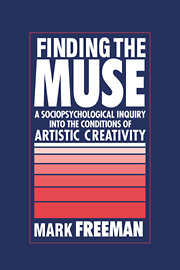Book contents
- Frontmatter
- Contents
- Acknowledgments
- Chapter 1 SOCIAL REALITY AND THE SPACE OF CREATIVITY
- Chapter 2 TO BE AN ARTIST
- Chapter 3 IN THE COMPANY OF OTHERS
- Chapter 4 CREATIVITY AND THE MARKET
- Chapter 5 THE DREAM OF ARTISTIC FREEDOM
- Chapter 6 THE CONDITIONS OF CREATIVITY
- Appendix: The Artists Project
- References
- Index
Appendix: The Artists Project
Published online by Cambridge University Press: 04 December 2009
- Frontmatter
- Contents
- Acknowledgments
- Chapter 1 SOCIAL REALITY AND THE SPACE OF CREATIVITY
- Chapter 2 TO BE AN ARTIST
- Chapter 3 IN THE COMPANY OF OTHERS
- Chapter 4 CREATIVITY AND THE MARKET
- Chapter 5 THE DREAM OF ARTISTIC FREEDOM
- Chapter 6 THE CONDITIONS OF CREATIVITY
- Appendix: The Artists Project
- References
- Index
Summary
The present inquiry is but a small portion of an ongoing longitudinal study of aspiring artists who attended the School of the Art Institute of Chicago during the mid-1960s. The study, which began in 1963 under the direction of Professors Getzels and Csikszentmihalyi at the University of Chicago, was at the outset largely experimental in nature, the primary purpose being to find out how various cognitive abilities, perceptual abilities, personality characteristics, and so on were related to the creation of works of art (see Getzels & Csikszentmihalyi, 1966, 1969, 1975, 1976). Dealing with those schooled as fine artists as well as those schooled as advertising artists, industrial artists, and art educators, this earlier work provided valuable insights into creativity. Most centrally, what Getzels and Csikszentmihalyi learned was that at the very core of the creative process was not problem solving, as many previous studies had maintained, but problem finding: Those with a discovery orientation toward their work, rather than an already established idea of what they would do, generally produced works of art that were judged by experts to be better than the rest. Moreover, upon entering the world of art, it was these same individuals who seemed to gain the most recognition.
What they also found, however, was that there was much more to becoming a successful artist (not to mention a consistently creative one) than a problem-finding orientation. With these individuals out of school only a few years, it was already becoming clear that certain kinds of people would fare better than others, those who were more gregarious, those who could withstand the pressures the art world brought to bear upon them.
- Type
- Chapter
- Information
- Finding the MuseA Sociopsychological Inquiry into the Conditions of Artistic Creativity, pp. 308 - 314Publisher: Cambridge University PressPrint publication year: 1994



